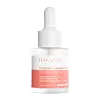What's inside
What's inside
 Key Ingredients
Key Ingredients

 Benefits
Benefits

 Concerns
Concerns

 Ingredients Side-by-side
Ingredients Side-by-side

Water
Skin ConditioningButylene Glycol
HumectantPropylene Glycol
HumectantGlycolic Acid
BufferingGlycerin
HumectantSuccinic Acid
BufferingSilanediol Salicylate
EmollientEthoxydiglycol
HumectantPEG-40 Hydrogenated Castor Oil
EmulsifyingTrideceth-9
EmulsifyingSodium Lactate
BufferingSodium PCA
HumectantHydroxypropyl Methylcellulose
Emulsion StabilisingDMDM Hydantoin
PreservativeGlycyrrhiza Glabra Root Extract
BleachingTriethanolamine
BufferingSodium Hydroxide
BufferingTetrasodium EDTA
Iodopropynyl Butylcarbamate
PreservativeFructose
HumectantGlycine
BufferingInositol
HumectantLactic Acid
BufferingNiacinamide
SmoothingUrea
BufferingGlabridin
BleachingBenzoic Acid
MaskingSodium Benzoate
MaskingSodium Methylparaben
PreservativeSodium Chloride
MaskingPropylparaben
PreservativeCI 14720
Cosmetic ColorantCI 15985
Cosmetic ColorantCI 42090
Cosmetic ColorantWater, Butylene Glycol, Propylene Glycol, Glycolic Acid, Glycerin, Succinic Acid, Silanediol Salicylate, Ethoxydiglycol, PEG-40 Hydrogenated Castor Oil, Trideceth-9, Sodium Lactate, Sodium PCA, Hydroxypropyl Methylcellulose, DMDM Hydantoin, Glycyrrhiza Glabra Root Extract, Triethanolamine, Sodium Hydroxide, Tetrasodium EDTA, Iodopropynyl Butylcarbamate, Fructose, Glycine, Inositol, Lactic Acid, Niacinamide, Urea, Glabridin, Benzoic Acid, Sodium Benzoate, Sodium Methylparaben, Sodium Chloride, Propylparaben, CI 14720, CI 15985, CI 42090
Water
Skin ConditioningNiacinamide
SmoothingButylene Glycol
HumectantHydroxyethyl Urea
HumectantPyridoxine Cyclic Phosphate
Skin ConditioningBetaine
HumectantMethyl Gluceth-20
HumectantEthoxydiglycol
HumectantSuccinic Acid
BufferingPhenoxyethanol
PreservativeSalicylic Acid
MaskingBiosaccharide Gum-1
HumectantPEG-20
HumectantGlycerin
HumectantCaprylic/Capric Triglyceride
MaskingAllantoin
Skin ConditioningDehydroxanthan Gum
Emulsion StabilisingEthylhexylglycerin
Skin ConditioningLecithin
EmollientDisodium EDTA
Tocopheryl Acetate
AntioxidantSodium Hyaluronate
HumectantHarungana Madagascariensis Extract
Skin ConditioningAscorbic Acid
AntioxidantWater, Niacinamide, Butylene Glycol, Hydroxyethyl Urea, Pyridoxine Cyclic Phosphate, Betaine, Methyl Gluceth-20, Ethoxydiglycol, Succinic Acid, Phenoxyethanol, Salicylic Acid, Biosaccharide Gum-1, PEG-20, Glycerin, Caprylic/Capric Triglyceride, Allantoin, Dehydroxanthan Gum, Ethylhexylglycerin, Lecithin, Disodium EDTA, Tocopheryl Acetate, Sodium Hyaluronate, Harungana Madagascariensis Extract, Ascorbic Acid
 Reviews
Reviews

Ingredients Explained
These ingredients are found in both products.
Ingredients higher up in an ingredient list are typically present in a larger amount.
Butylene Glycol (or BG) is used within cosmetic products for a few different reasons:
Overall, Butylene Glycol is a safe and well-rounded ingredient that works well with other ingredients.
Though this ingredient works well with most skin types, some people with sensitive skin may experience a reaction such as allergic rashes, closed comedones, or itchiness.
Learn more about Butylene GlycolEthoxydiglycol is a synthetic solvent.
Solvents are used to keep ingredients together in a product. They can help dissolve ingredients to stable bases or help evenly distribute ingredients throughout the product.
Ethoxydiglycol also helps deliver other key ingredients into the skin.
Learn more about EthoxydiglycolGlycerin is already naturally found in your skin. It helps moisturize and protect your skin.
A study from 2016 found glycerin to be more effective as a humectant than AHAs and hyaluronic acid.
As a humectant, it helps the skin stay hydrated by pulling moisture to your skin. The low molecular weight of glycerin allows it to pull moisture into the deeper layers of your skin.
Hydrated skin improves your skin barrier; Your skin barrier helps protect against irritants and bacteria.
Glycerin has also been found to have antimicrobial and antiviral properties. Due to these properties, glycerin is often used in wound and burn treatments.
In cosmetics, glycerin is usually derived from plants such as soybean or palm. However, it can also be sourced from animals, such as tallow or animal fat.
This ingredient is organic, colorless, odorless, and non-toxic.
Glycerin is the name for this ingredient in American English. British English uses Glycerol/Glycerine.
Learn more about GlycerinNiacinamide is a multitasking form of vitamin B3 that strengthens the skin barrier, reduces pores and dark spots, regulates oil, and improves signs of aging.
And the best part? It's gentle and well-tolerated by most skin types, including sensitive and reactive skin.
You might have heard of "niacin flush", or the reddening of skin that causes itchiness. Niacinamide has not been found to cause this.
In very rare cases, some individuals may not be able to tolerate niacinamide at all or experience an allergic reaction to it.
If you are experiencing flaking, irritation, and dryness with this ingredient, be sure to double check all your products as this ingredient can be found in all categories of skincare.
When incorporating niacinamide into your routine, look out for concentration amounts. Typically, 5% niacinamide provides benefits such as fading dark spots. However, if you have sensitive skin, it is better to begin with a smaller concentration.
When you apply niacinamide to your skin, your body converts it into nicotinamide adenine dinucleotide (NAD). NAD is an essential coenzyme that is already found in your cells as "fuel" and powers countless biological processes.
In your skin, NAD helps repair cell damage, produce new healthy cells, support collagen production, strengthen the skin barrier, and fight environmental stressors (like UV and pollution).
Our natural NAD levels start to decline with age, leading to slower skin repair, visible aging, and a weaker skin barrier. By providing your skin niacinamide, you're recharging your skin's NAD levels. This leads to stronger, healthier, and younger looking skin.
Another name for vitamin B3 is nicotinamide. This vitamin is water-soluble and our bodies don't store it. We obtain Vitamin B3 from either food or skincare. Meat, fish, wheat, yeast, and leafy greens contain vitamin B3.
The type of niacinamide used in skincare is synthetically created.
Learn more about NiacinamideSuccinic acid is an odorless white powder. It is naturally found in our bodies but can also be derived from living organisms.
Succinic acid is water-soluble. The pH level of this ingredient is between 4.2 and 5.6.
While succinic acid posesses antimicrobial, antioxidant, and anti-inflammatory properties, these properties have not been studied in skincare products.
Fun fact: Succinic acid was known as the 'spirit of amber' in the past. This is because it used to be derived from distilling amber.
Learn more about Succinic AcidWater. It's the most common cosmetic ingredient of all. You'll usually see it at the top of ingredient lists, meaning that it makes up the largest part of the product.
So why is it so popular? Water most often acts as a solvent - this means that it helps dissolve other ingredients into the formulation.
You'll also recognize water as that liquid we all need to stay alive. If you see this, drink a glass of water. Stay hydrated!
Learn more about Water